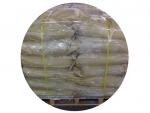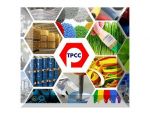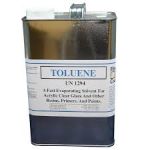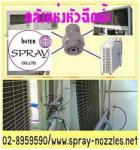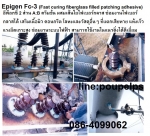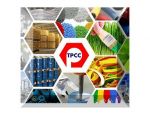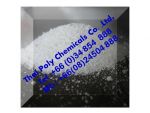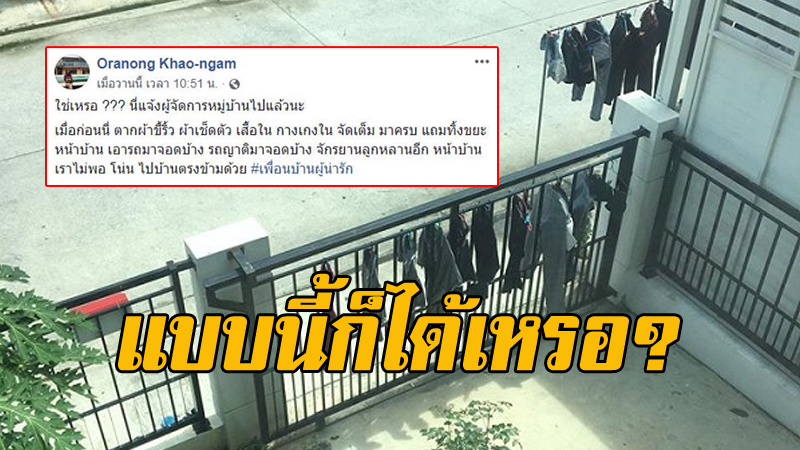ทิทาเนียมไดออกไซด์ TiO2 Titanium Dioxide |
฿1 |
|
ชื่อผู้ประกาศ : ไทยโพลีมิเนอรัล เบอร์โทรศัพท์ : 034854888 โทรศัพท์มือถือ : 0800160016 ที่อยู่ : 36/5 ม.9 ต.นาดี อ.เมืองสมุทรสาคร จ.สมุทรสาคร ร้าน ไทยโพลีมิเนอรัล |
Titanium Dioxide, TiO2, ทิทาเนียมไดออกไซด์, ไททาเนียมไดออกไซด์
ไทเทเนียมไดออกไซด์เป็นสารเก่าแก่ชนิดหนึ่งเท่าๆกับโลกของเรา
และเป็นหนึ่งใน 50ชนิดของสารที่ผลิตมากที่สุดทั่วโลก ลักษณะโดยทั่วไปมีสีขาว ทึบแสงเกิดเองตามธรรมชาติมี 2 รูปแบบ ใหญ่ คือ รูไทล์และอานาเทสทั้ง 2รูปแบบมีไทเทเนียมไดออกไซด์บริสุทธิ์อยู่กับสารปนเปื้อนต้องผ่านกระบวนการทางเคมีจึงจะนำสารปนเปื้อนออกได้เหลือไว้แต่ไทเทเนียมไดออกไซด์บริสุทธิ์ไทเทเนียมไดออกไซด์เป็นสารสีที่มีสีขาวมีประโยชน์สำหรับการใช้งานได้หลากหลายเนื่องจากมันไม่มีกลิ่นและมีความสามารถในการดูดซับแร่ชนิดนี้พบได้ในหลายผลิตภัณฑ์ตั้งแต่สีทาบ้านไปถึงอาหารและเครื่องสำอางในกลุ่มเครื่องสำอางใช้เพื่อหลายวัตถุประสงค์ไทเทเนียมไดออกไซด์เป็นสารสีที่มีสีขาวเป็นตัวที่ทำให้เกิดการทึบแสงและเป็นตัวป้องกันแสงแดด อาทิเช่น อุตสาหกรรมการทำสีผสมอาหารที่เป็นสีขาว ใช้เป็นสารเคลือบขนมช็อกโกแลต ยาสีฟัน เป็นส่วนประกอบในแป้ง สบู่ เครื่องสำอาง ลิปสติก ครีมกันแดด ใช้ในผลิตภัณฑ์บรรจุอาหาร ผสมในยาสูบ และสีทาอาคาร ฯลฯ แม้กระทั่งการทำรากฟันเทียม ไม่ใช่สารที่อยู่ในกลุ่มของสารก่อมะเร็ง สารที่ก่อให้เกิดการกลายพันธุ์ สารที่ทำให้ตัวอ่อนในครรภ์เกิดความผิดปกติ หรือสารที่มีพิษ ด้วยเหตุนี้จึงสรุปได้ว่าไทเทเนียมไดออกไซด์ไม่ใช่สารที่มีพิษ โดยทั่วไปมีความปลอดภัยในการใช้กับอาหาร ยา สี และเครื่องสำอาง แต่นี่ไม่ใช่ข้อยุติสำหรับการโต้แย้ง ความปลอดภัยของไทเทเนียมไดออกไซด์ในอีกรูปแบบหนึ่งยังไม่ได้กล่าวถึง หนึ่งในรูปแบบของแร่ หรือการสกัดแร่รวมถึงไทเทเนียมไดออกไซด์ที่ควรคำนึงถึงคือ อนุภาคขนาดเล็กหรืออนุภาคขนาดนาโน ด้วยความก้าวหน้าทางด้านเทคโนโลยีทำให้สามารถทำแร่ให้มีขนาดเล็กได้อย่างที่ไม่เคยเป็นมาก่อน ขณะที่หลายส่วนชื่นชมกับเทคโนโลยีใหม่ บางส่วนเตือนถึงอันตรายที่ซ่อนอยู่ภายในที่มาถึงร่างกายของเรา มีการศึกษาพบว่าอนุภาคขนาดเล็กของไทเทเนียมไดออกไซด์รูปแบบอนาเทส
Titanium dioxide, also known as
titanium(IV) oxide or titania, is the naturally occurring oxide of titanium, chemical formula TiO2. When used as a pigment, it is called titanium white, Pigment White 6 (PW6), or CI 77891. Generally it is sourced from ilmenite, rutile and anatase. It has a wide range of applications, from paint to sunscreen to food colouring. When used as a food colouring, it has E number
Production
The production method depends on
the feedstock. The most common method for the production of titanium dioxide utilizes
ilmenite. Ilmenite is mixed with sulfuric acid. This reacts to remove the iron
oxide group in the ilmenite. The by-product iron(II) sulfate is crystallized
and filtered-off to yield only the titanium salt in the digestion solution.
This product is called synthetic rutile. This is further processed in a similar
way to rutile to give the titanium dioxide product. Synthetic rutile and
titanium slags are made especially for titanium dioxide production.[18] The use
of ilminite ore usually only produces pigment grade titanium dioxide. Another
method for the production of synthetic rutile from ilminite utilizes the Becher
Process.Rutile is the second most abundant
mineral sand. Rutile found in primary rock cannot be extracted hence the deposits containing rutile sand can be mined meaning a reduced availability to the high concentration ore. Crude titanium dioxide (in the form of rutile or synthetic rutile) is purified via converting to titanium tetrachloride in the chloride process. In this process, the crude ore (containing at least 70% TiO2) is reduced with carbon, oxidized with chlorine to give titanium tetrachloride; i.e., carbothermal chlorination. This titanium tetrachloride is distilled, and re-oxidized in a pure oxygen flame or plasma at 1500?2000 K to give pure titanium dioxide while also regenerating chlorine.[19] Aluminium chloride is often added to the process as a rutile promotor; the product is mostly anatase in its absence. The preferred raw material for the chloride process is natural
One method for the production of
titanium dioxide with relevance to nanotechnology is solvothermal Synthesis of
titanium dioxide.Applications
The most important application
areas are paints and varnishes as well as paper and plastics: They process
about 80% of the world's titanium dioxide consumption. Other pigment
applications like printing inks, fibers, rubber, cosmetic products and
foodstuffs account for another 8%. The rest is used in other applications, for
instance the production of technical pure titanium, glass and glass ceramics,
electrical ceramics, catalysts, electric conductors and chemical intermediates.
Pigment
Titanium dioxide is the most
widely used white pigment because of its brightness and very high refractive
index, in which it is surpassed only by a few other materials. Approximately
4.6 million tons of pigmentary TiO2 are used annually worldwide, and this
number is expected to increase as utilization continues to rise.[25] When deposited
as a thin film, its refractive index and colour make it an excellent reflective
optical coating for dielectric mirrors and some gemstones like "mystic
fire topaz". TiO2 is also an effective opacifier in powder form, where it
is employed as a pigment to provide whiteness and opacity to products such as
paints, coatings, plastics, papers, inks, foods, medicines (i.e. pills and
tablets) as well as most toothpastes. In paint, it is often referred to
offhandedly as "the perfect white", "the whitest white", or
other similar terms. Opacity is improved by optimal sizing of the titanium
dioxide particles. Some grades of titanium based pigments as used in sparkly
paints, plastics, finishes and pearlescent cosmetics are man-made pigments
whose particles have two or more layers of various oxides ? often titanium
dioxide, iron oxide or alumina ? in order to have glittering, iridescent and or
pearlescent effects similar to crushed mica or guanine-based products. In
addition to these effects a limited color change is possible in certain
formulations depending on how and at which angle the finished product is
illuminated and the thickness of the oxide layer in the pigment particle; one
or more colours appear by reflection while the other tones appear due to
interference of the transparent titanium dioxide layers.[26] In some products,
the layer of titanium dioxide is grown in conjunction with iron oxide by
calcination of titanium salts (sulfates, chlorates) around 800 ?C or other
industrial deposition methods such as chemical vapour deposition on substrates
such as mica platelets or even silicon dioxide crystal platelets of no more
than 50 ?m in diameter. The iridescent effect in these titanium oxide particles
(which are only partly natural) is unlike the opaque effect obtained with usual
ground titanium oxide pigment obtained by mining, in which case only a certain
diameter of the particle is considered and the effect is due only to
scattering.In ceramic glazes titanium dioxide
acts as an opacifier and seeds crystal formation.Titanium dioxide has been shown
statistically to increase skimmed milk's whiteness, increasing skimmed milk's
sensory acceptance score.Titanium dioxide is used to mark
the white lines of some tennis courts.The exterior of the Saturn V
rocket was painted with titanium dioxide; this later allowed astronomers to
determine that J002E3 was the S-IVB stage from Apollo 12 and not an asteroid.Sunscreen and UV blocking pigments
in the industryIn cosmetic and skin care
products, titanium dioxide is used as a pigment, sunscreen and a thickener. It
is also used as a tattoo pigment and in styptic pencils. Titanium dioxide is
produced in varying particle sizes, oil and water dispersible, and in certain
grades for the cosmetic industry.Titanium dioxide is found in
almost every sunscreen with a physical blocker because of its high refractive
index, its strong UV light absorbing capabilities and its resistance to
discolouration under ultraviolet light. This advantage enhances its stability
and ability to protect the skin from ultraviolet light. Nano-scaled titanium
dioxide particles are primarily used in sun screen lotion because they scatter
visible light less than titanium dioxide pigments while still providing UV
protection. Sunscreens designed for infants or people with sensitive skin are
often based on titanium dioxide and/or zinc oxide, as these mineral UV blockers
are believed to cause less skin irritation than other UV absorbing chemicals.This pigment is used extensively
in plastics and other applications not only as a white pigment or an opacifier
but also for its UV resistant properties where the powder disperses the light ?
unlike organic UV absorbers ? and reduces UV damage, due mostly to the
extremely high refractive index of the particles. Certain polymers used in
coatings for concrete or those used to impregnate concrete as a reinforcement
are sometimes charged with titanium white pigment for UV shielding in the
construction industry, but it only delays the oxidative photodegradation of the
polymer in question, which is said to "chalk" as it flakes off due to
lowered impact strength and may crumble after years of exposure in direct
sunlight if UV stabilizers have not been included, Titanium dioxide, particularly
in the anatase form, is a photocatalyst under ultraviolet (UV) light. Recently
it has been found that titanium dioxide, when spiked with nitrogen ions or
doped with metal oxide like tungsten trioxide, is also a photocatalyst under
either visible or UV light. The strong oxidative potential of the positive
holes oxidizes water to create hydroxyl radicals. It can also oxidize oxygen or
organic materials directly. Titanium dioxide is thus added to paints, cements,
windows, tiles, or other products for its sterilizing, deodorizing and
anti-fouling properties and is used as a hydrolysis catalyst. It is also used
in dye-sensitized solar cells, which are a type of chemical solar cell (also
known as a Graetzel cell).The photocatalytic properties of
titanium dioxide were discovered by Akira Fujishima in 1967 and published in 1972. The process on the surface of the titanium dioxide was called the Honda-Fujishima effect. Titanium dioxide has potential for use in energy production: as a photocatalyst, it can carry out hydrolysis; i.e., break water into hydrogen and oxygen. With the hydrogen collected, it could be used as a fuel. The efficiency of this process can be greatly improved by doping the oxide with carbon. Further efficiency and durability has been obtained by introducing disorder to the lattice structure of the surface layer of titanium
Titanium dioxide can also produce
electricity when in nanoparticle form. Research suggests that by using these
nanoparticles to form the pixels of a screen, they generate electricity when
transparent and under the influence of light. If subjected to electricity on
the other hand, the nanoparticles blacken, forming the basic characteristics of
a LCD screen. According to creator Zoran Radivojevic, Nokia has already built a
functional 200-by-200-pixel monochromatic screen which is energetically
self-sufficient.In 1995 Fujishima and his group
discovered the superhydrophilicity phenomenon for titanium dioxide coated glass
exposed to sun light. This resulted in the development of self-cleaning glass
and anti-fogging coatings.TiO2 incorporated into outdoor
building materials, such as paving stones in noxer blocks[38] or paints, can
substantially reduce concentrations of airborne pollutants such as volatile
organic compounds and nitrogen oxides.A photocatalytic cement that uses
titanium dioxide as a primary component, produced by Italcementi Group, was
included in Time's Top 50 Inventions of 2008.Attempts have been made to photocatalytically
mineralize pollutants (to convert into CO2 and H2O) in waste water. TiO2 offers
great potential as an industrial technology for detoxification or remediation
of wastewater due to several factors:1.The process uses natural oxygen and sunlight
and thus occurs under ambient conditions; it is wavelength selective and is
accelerated by UV light.2.The photocatalyst is inexpensive, readily
available, non-toxic, chemically and mechanically stable, and has a high
turnover.3.The formation of photocyclized intermediate
products, unlike direct photolysis techniques, is avoided.4.Oxidation of the substrates to CO2 is
complete.5.TiO2 can be supported on suitable reactor
substrates.Electronic data storage medium
In 2010, researchers at the University
of Tokyo, Japan have created a crystal form of titanium oxide with particles 5
to 20 nanometers that can be switched between two states with light. Use of the
5 nm particles could theoretically lead to a 25 TB storage disc.Titanium dioxide in solution or
suspension can be used to cleave protein that contains the amino acid proline
at the site where proline is present. This breakthrough in cost-effective
protein splitting took place at Arizona State University in 2006.Titanium dioxide is also used as a material in
the memristor, a new electronic circuit element. It can be employed for solar
energy conversion based on dye, polymer, or quantum dot sensitized
nanocrystalline TiO2 solar cells using conjugated polymers as solid
electrolytes.Synthetic single crystals and films of TiO2
are used as a semiconductor,[46] and also in Bragg-stack style dielectric
mirrors due to the high refractive index of TiO2 (2.5?2.9).Titanium dioxide pigment (chemical
symbol: TiO2) is an inorganic white pigment found in an array of end-uses,
including coatings and plastics, which account for more than 80 percent of
global consumption. Tronox markets a
range of titanium dioxide pigment grades, and our talented team of scientists
works to enhance the performance of products in our customers? current and
future applications.Tronox is one of only five major
producers of TiO2 with proprietary chloride process technology. The chloride process, which accounts for 100
percent of pigment production gross capacity, produces pigment grades with a brighter appearance that is often preferred by manufacturers of coatings and
TiO2 is among the lowest-cost
producers of the product globally. This
is of particular importance as it positions TiO2 to be competitive through all
facets of the TiO2 cycle. In addition,
our company?s three TiO2 production facilities are strategically positioned in
key geographies to reach key markets worldwide.Titanium Technologies is the
world?s largest manufacturer of titanium dioxide products. We are dedicated to
providing value for our customers, who subsequently supply the world with
coatings, plastics, laminate and paper products. We deliver industry-leading
innovation that addresses the growing worldwide demand for high quality
titanium dioxide by working to create brighter, more efficient pigments. Even
beyond the products we deliver, we also strive to be a partner that enables the
development of sustainable solutions to customer challenges, further enhancing
their business performance. In addition to being known as a leader in safety
and ethics within the TiO2 industry for over 80 years, Titanium Technologies is
a technological innovator. Since the invention and implementation of the
chloride manufacturing process in the 1950?s, consistent advancement in TiO2
pigment design has expanded its quality and utility across the numerous
applications in which it is a component. Fostering innovation to improve the
quality of our customers? experience as well as our products has always been a
critical component of our success, and will continue to do so as we build upon
our 80+ years of expertise.Molecular formulation:TiO2
Molecular weight:79.9 is 4.1,and
the chemical properties are stable.Characteristic, Silicon
oxide-alunminum oxide(more silicon less aluminum)coated,strong covering
power,good dispersible power,good optical properties,extremely good durability
and chalking resistance,good dry powder fluidity,very good gardner salability.Usage:Suitable for
coatings,plastics,plastic steel sectional materials,rubber products,paper
making,leather products,automobile surface paintings,automobile refinish
paintings,etc.Package:Plastic and paper compound
value bag,net of each bag:25kg,1000kg etc.The package of the product exported
can be negotiated with the client.TiO2 is High-gloss paint,
Decorative coating, Coil coatings, Water-based paint, Oil-based paint, plastics
(PVC, PE, polystyrene and polyurethane), masterbatch, rubber, high-grade
printing ink and paper?Main Property
1.Excellent whiteness
2.Excellent dispersibility
3.Excellent weatherability
4.High tinting power
TiO2 Rutile Titanium Dioxide for
General Purpose is general used in1.indoor&outdoor coatings
2.interior and exterior latex
paints3.industrial coatings
4.powder coatings
5.plastics(PVC,PE)
6.masterbatch
7.printing ink and paper making,
etc....
สอบถามข้อมูลเพิ่มเติมได้ที่
ฝ่ายขายThai Poly Chemicals Co., Ltd.
บริษัท ไทยโพลีเคมิคอล จำกัด
ที่อยู่36/5 ม.9 แขวง/ตำบลนาดี
เขต/อำเภอเมืองสมุทรสาคร
จังหวัดสมุทรสาคร รหัสไปรษณีย์74000Tel.: 034854888,
034496284
Fax.: 034854899,
034496285
Mobile: 0824504888,
0800160016
Website :
www.thaipolychemicals.comEmail1 : thaipolychemicals@hotmail.com
Email2 : info@thaipolychemicals.com
RutileTitaniumPowderAnataseTiO2Dioxideทิทาเนียมไดออกไซด์Pasteอนาทัสรูไทล์

